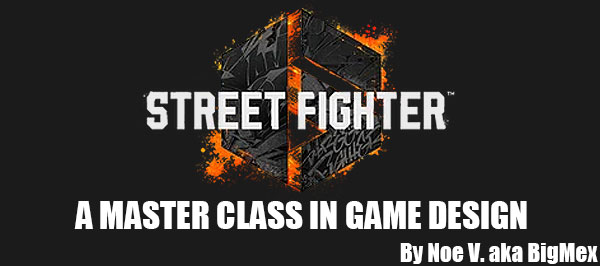
In the previous blog I talked about how Capcom was revising old character designs, and trying to make them more palatable to modern audiences. Every popular character was getting a redo. In the early stages of SFII Blanka had started off as an ugly Black brute in chains. He was turned into a green mutant, a wild man from the jungle. For SF6 this wild man was dressed in overalls. He was turned into a businessman starting up his own jungle tourism company. In the Street Fighter II concept art Dhalsim had started off as the Great Tiger, an Indian mystic wearing a Ganesh Balinese costume. He was turned into a stretchy limbed yoga master. Some of his more offensive costuming choices, specifically the child skull necklace was removed, and replaced with a necklace depicting the mudras. He would become a yogi, and instructor of yoga at a temple.
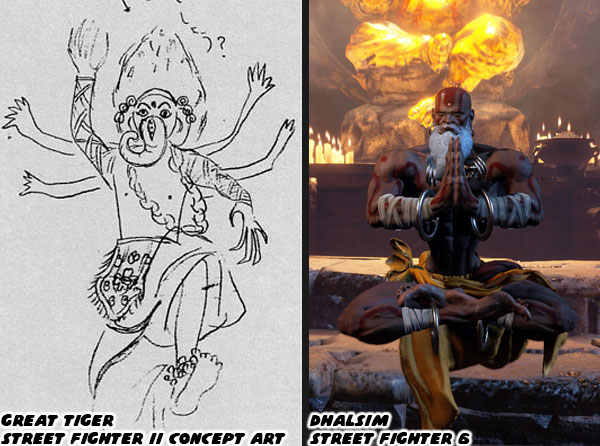
You would think that following the success of SFII the designers at Capcom would be more mindful of their international audience. For the most part the studio was able to create characters around a certain form of fighting. Whether they represented kung-fu, karate, wrestling, Muay Thai, or MMA. Those fighters had a look that reflected their style. The problem was when trying to create a design for a new fighter that didn’t represent a certain style. Blanka, and Dhalsim were examples of that. They fought in an unorthodox fashion, and thus had an unorthodox look to them. Before starting on a new game the designers would throw out all sorts of ideas, and see which ones stuck. For example one of the ideas for a SFIII character was simply titled “Rollerblade.” This character had some odd armor, and a helmet / hairstyle.
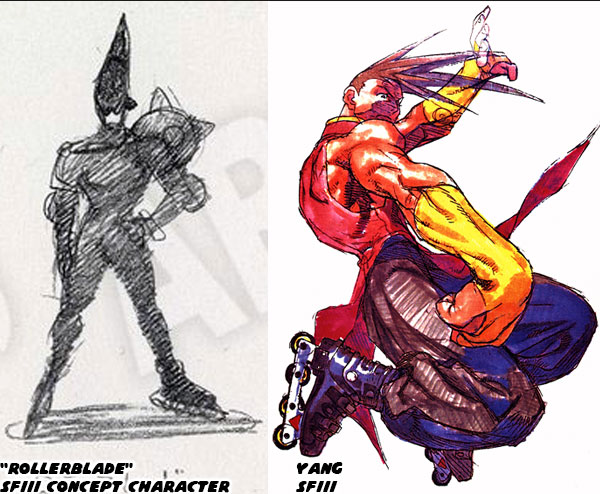
Designing an entire fighting style around a person that could inline skate didn’t go anywhere. Instead the studio took the skating, and made it a hobby for one of the kung-fu twins they were working on. The older of the two Yun, would be a skateboarder,
inspired by Ken Lieu an actual skate legend. Yang was more than likely based on
the Yasutoko Brothers, Takeshi, and Eito. Both of them were aggressive inline world champs. I would argue however that at least the spiky helmet in the concept sketch was turned into spiky hair for the younger twin. Not every design was as neutral. Some designs were right on the edge of offensive. What might have been meant as an homage to a certain archetype could be seen a stereotype to another person.
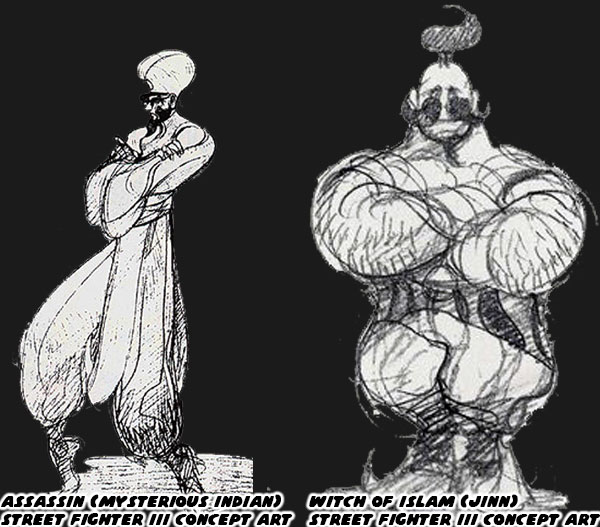
Let’s take a look at how the studio had been trying to incorporate a Middle Eastern character in the franchise for over 25 years. Some of the oldest drafts in Street Fighter III had a mysterious Indian assassin character. This fighter was dressed in classic Arabian fashion. I mean these costumes might have worked in a storybook, or Disney cartoon. That concept was fairly mild compared to the Witch of Islam. An enormous musclebound character that could be mistaken for a djinn, or genie. If you don’t think the design could be considered problematic then I wouldn’t know what to tell you.
The Street Fighter 6 team didn't seem to be able to let some of their older designs go, no matter how far out of step they were with representation.
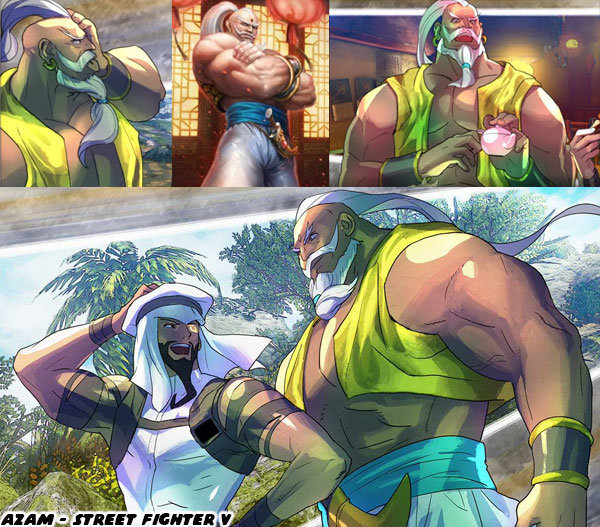
In Street Fighter V there was an NPC named Azam that was the attendant / bodyguard to Rashid. The duo represented a lost kingdom in the desert. Azam wore costuming that made sense in one of the
classic tales of Sindbad. You could easily imagine the musclebound character in a fight with a cyclops, pirate, or sea monster. He looked nothing like a modern person from the Middle East. He was reminiscent of the Witch of Islam concept. Capcom thankfully thought better than making him a main character. The studio still had to develop somebody whose look spoke to Middle Eastern culture. I would argue that they leaned heavily into orientalism when presenting Rashid in Street Fighter V. The studio didn’t lighten their approach to Azam when updating him for SF6, Rashid was another story.
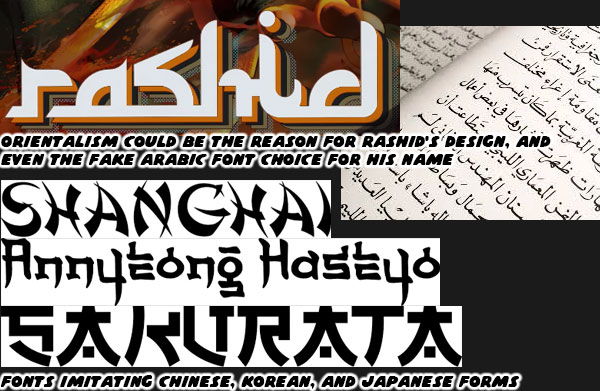
The developers didn’t second guess using a font that imitated the
Arabic language, and script when announcing his return. It was a clever design choice, and I'm certain that Capcom had tremendous love, and respect for the people of the Middle East. This did not mean that some of their choices were not rooted in outdated ideas.
Orientalism was the representation of Asia, especially the Middle East, in a stereotyped way that is regarded as embodying a colonialist attitude. This was something that had always been a part of character design from Japanese studios. I'm talking about magic, harems, genies, and inflatable characters! I created a series exploring the origins of these tropes. If you have some time please visit the following links;
The Middle Eastern fighter, pt. 1,
The Middle Eastern fighter, pt. 2,
The Middle Eastern fighter, pt. 3, and
The Middle Eastern fighter, pt. 4 (is where I talk about Rashid).
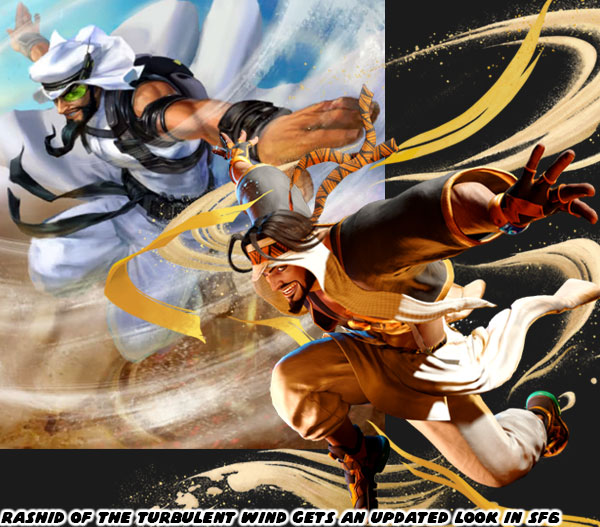
I would say that the newest version of Rashid was greatly improved over the previous. Let’s take a look at the differences between the designs in SFV, and SF6. One of the biggest problems I saw with the original look was the plain color scheme assigned to Rashid. Street Fighter II set a standard for character costumes, one of the reasons they worked was by sheer coincidence. The hardware that Capcom developed on was powerful for its time, but still had a limited sprite size, number of animations, and particularly limited palette of colors. The designers made sure that each character was given a strong primary color, and a complimentary second color. They would be easy to pick out of a crowd. If you think about Ken, and Ryu the colors that come to mind are red, and white. When you think of Chun-Li the color is blue. When I mention Blanka the color is green. You get the idea. For Rashid the color was primarily white, with a black belt. Something was lost when his costume was very similar to Ryu’s.
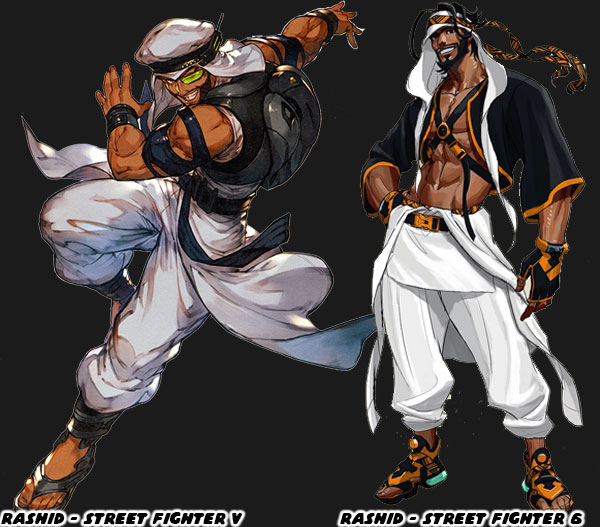
Designer Yusuke Hashimoto gave Rashid a makeover without losing too many elements from his original look. The first thing he did was expand the the secondary color black to cover the top half of his costume, and added orange as an accent color to separate him from Ryu. He also shortened the beard into something more realistic. He also did away with the overt technology the fighter relied on. Rashid was an expert at parkour, he was exceptionally quick, agile, and athletic. These things did not necessarily make him a dangerous fighter. He supplemented his strikes through technology. Hidden in his boots, and costume were tiny engines that created whirlwinds. In his original look he wore a large backpack to power these devices. The new costume got rid of these things.
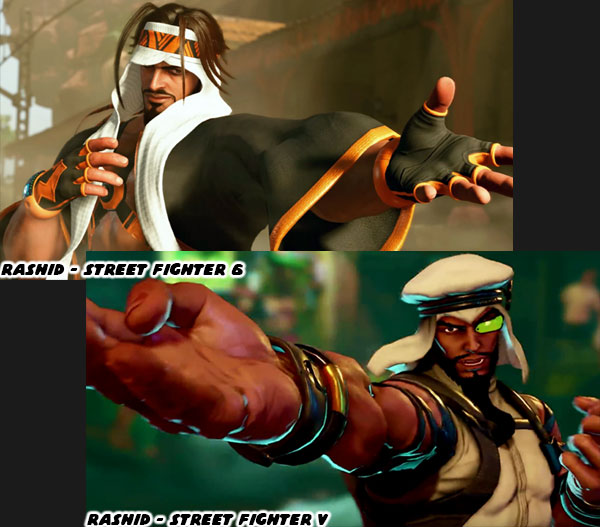
His keffiyeh, the traditional headscarf was previously large, and puffy. This was swapped out to a visor head wrap with a long orange headband. His green viewfinder was ditched, as he was not a Sayan from Dragon Ball Z. His shoulders were now covered, there was no sign of the straps that had randomly criss crossed his arms. His smart devices were now integrated into his gloves. His sandals used to be plain looking, but were now stylized more like sneakers with electronics. Mr. Hashimoto pulled Rashid’s design into the 21st century, tried to leave the fairy tale elements out, while still making it unlike any traditional Arab costume. It followed the rules that went into the costumes of the other classic characters. After all Ryu, Chun-Li, and Guile’s costumes looked authentic, but only pulled a few cues from actual uniforms. His work should be studied in greater depth by anyone looking to create, or update a library of fighters.
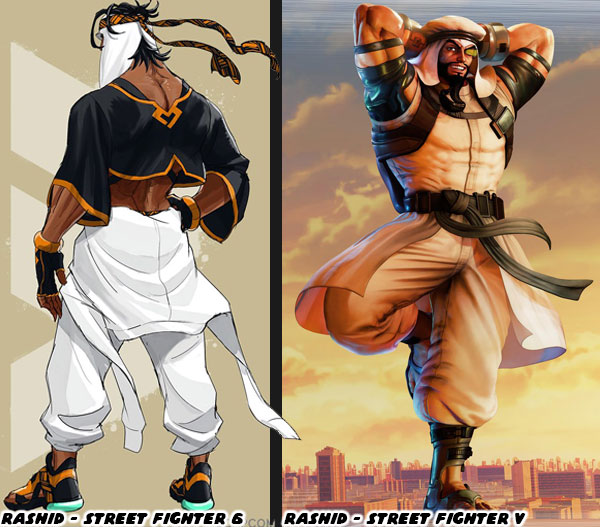
Street Fighter 6 was evolving with the times, and pushing for a more diverse cast, without losing their unique eye. The Mysterious Assassin, and the Witch of Islam may have been the inspiration behind Rashid, and Azam, however they more directly influenced the creation of F.A.N.G. in SFV, and A.K.I. in SF6. We will look at how in the next blog. I hope to see you back for the next entry. If you are a long time fan of Final Fight, or Street Fighter then I would like to hear your impressions of SF6. If you have never played any game previously then tell me your experiences in the comments section please. As always if you would like to sponsor me
please visit my Patreon page and consider donating each month, even as little as $1 would help make better blogs and even podcasts!




















I'm not sure where the idea that Rashid's wind powers in SF5 are tech based comes from. I've never seen any Capcom source anywhere that suggested it. And the fact that his Story costume(which are still canon outfits) has none of that suggests that it's not needed for him to control the wind.
ReplyDeleteAll of the gadgetry he wears is just meant to signify what a technophile he is. He loves gadgets, but none of it is related to his fighting abilities. Just like his camera in SF6.